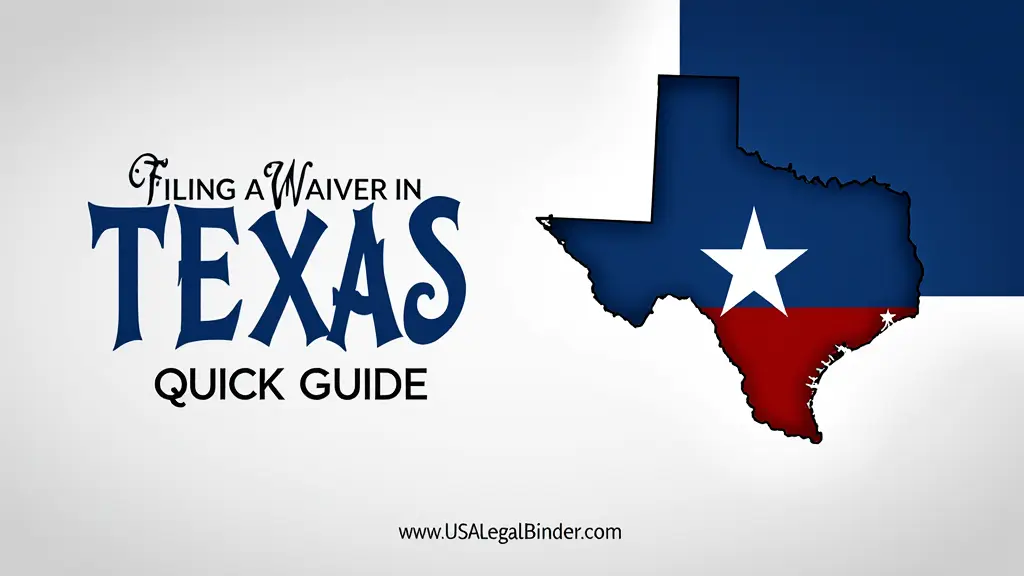waiver Texas filing — If you cannot afford court costs or need to document inability to pay, filing a waiver in Texas may remove or defer fees. This guide explains Texas-specific requirements, the correct forms, and step-by-step filing instructions to help you apply successfully.
The instructions below focus only on Texas procedures, local court practices, and authoritative Texas resources. Read each section carefully and gather documents before you file.
Quick Overview / What this for Waiver in Texas covers
In Texas, a “waiver” most commonly refers to a court fee waiver or a sworn statement of indigence used in civil, family, probate, and appellate matters.
Common uses for a waiver in Texas include:
- Requesting the court to waive filing fees and service costs because of financial hardship.
- Asking to waive the requirement to post an appeal bond due to inability to pay.
- Submitting a court-approved affidavit in lieu of payment for certain administrative filings.
State-specific Requirements (waiver Texas filing)
Texas courts evaluate waiver requests under statewide rules and local court practices. The official statewide form and guidance come from the Texas Judicial Branch (Office of Court Administration).
Key Texas resources and agencies:
- Texas Judicial Branch (txcourts.gov) — official court forms and rules for fee waivers.
- Texas State Law Library (tsl.texas.gov) — public legal research and form instructions.
- County clerk and local district/justice courts — handle filings and may have county-specific instructions.
Residency and jurisdiction: you file the waiver in the court where your case is pending in Texas. The court will assess household income, benefits, and necessary expenses when determining eligibility.
Eligibility basics
- Receiving public benefits (e.g., SNAP, Medicaid) supports a waiver request.
- Low income combined with essential expenses may qualify you as indigent for fee purposes.
- Courts consider household size, dependents, and unavoidable medical or childcare costs.
Step-by-step How to Complete & Submit
Follow these numbered steps to complete the standard Texas fee-waiver filing.
- Download the correct form. Use the Texas Judicial Branch’s “Statement of Inability to Afford Payment of Court Costs or an Appeal Bond.” Obtain the current PDF from the Texas Judicial Branch forms page.
- Collect supporting documents. Gather recent pay stubs, benefits award letters (SNAP, Medicaid), unemployment statements, or a letter from a benefits office.
- Complete the form carefully. Fill every field: case number, court name, household members, income, monthly expenses, and public benefits. Be truthful—false statements carry penalties.
- Sign as instructed. The form often allows a sworn declaration under penalty of perjury instead of notarization; follow the form’s signature instructions exactly.
- Attach proof. Add copies of pay stubs, benefits notices, or other documentation that supports your claim of inability to pay.
- File with the court clerk. Submit the completed form and attachments in person, by mail, or electronically if the court accepts e-filing. Request a stamped copy as proof of filing.
- Respond to court instructions. The judge may issue an order, request additional documents, or schedule a brief hearing—comply promptly.
Typical documents needed for a Texas waiver filing include:
- Statement of Inability to Afford Payment of Court Costs or an Appeal Bond — Texas Judicial Branch standard form (bilingual version available).
- Proof of public benefits (SNAP, Medicaid, TANF, SSI) or written verification of enrollment.
- Recent pay stubs (last 4–8 weeks) or employer income verification.
- Documentation of unemployment benefits or disability income when applicable.
- Identification (Texas driver’s license or state ID) and case-related documents.
Processing Time, Fees and Deadlines Waiver in Texas
Filing the waiver form itself is free. Processing times vary by county and court workload.
- Typical processing: Clerks forward forms to judges within days; some courts may set a short hearing.
- Fees: If the court grants the waiver, applicable filing fees and bonds may be waived; otherwise you remain responsible for costs.
- Deadlines: File the waiver with your initial pleading or before an appeal deadline to avoid dismissal or forfeiture of rights.
Common Mistakes to Avoid
- Using outdated versions of the form—always download from the official Texas Judicial Branch site.
- Failing to attach proof of income or public benefits.
- Leaving signature blocks incomplete or unsigned.
- Assuming county clerks will automatically submit the form for you—confirm filing procedures locally.
- Not keeping a stamped copy of the filed waiver for your records.
Access authoritative Texas resources for forms and guidance:
FAQs
A: Use the “Statement of Inability to Afford Payment of Court Costs or an Appeal Bond” from the Texas Judicial Branch.
Q: Will a waiver be approved automatically?
A: No. The court reviews documentation and may deny the waiver if it finds you can reasonably pay the costs.
Q: Can I waive an appeal bond in Texas?
A: Yes. The statewide form includes a section for appeals and appeal bonds; file before appeal filing deadlines.
Q: What if my waiver is denied?
A: If denied, you must pay the required fees or request additional review; you may also seek legal aid for further assistance.
A: Legal aid organizations, county self-help centers, and the Texas State Law Library offer guidance. See TexasLawHelp for potential assistance providers.
Conclusion & Call to Action
Filing a waiver in Texas requires the correct form, truthful financial disclosures, and supporting documentation. Start by downloading the current “Statement of Inability to Afford Payment of Court Costs or an Appeal Bond” from the Texas Judicial Branch and gather proof of income or benefits.
Always consult the official Texas Judicial Branch forms page or the Texas State Law Library for the latest requirements. For case-specific advice, consider contacting a qualified Texas attorney.
Internal link suggestion: For related procedures, link this article to “See our guide on affidavits in Texas” on USAlegalBinder.com.
